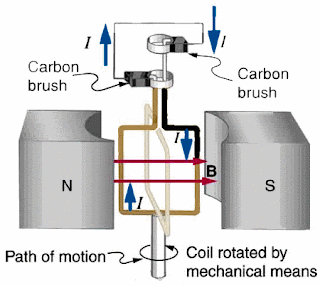Basic Concept of a Transformer
The concept of a transformer is actually pretty simple. Alternating current, the kind produced by a generator (voltage cycling through positive and negative values) is converted from a high voltage-low amp stream to a low-voltage high-amp stream, or the reverse. The ratios can be adjusted by some types of transformers. Transformer output is the same frequency as input.
 |
| FIG 1: Basic Concept of Generator |
 |
| FIG 2: Basic Concept of Tranformer |
Typically, transformers are used for "stepping up" the voltage of an electric power source so it can be sent over the grid. By increasing the voltage, one can make each ampere "do more," and it's less energy wasted to send over a long power line. When the current arrives at the distribution substation, transformers step the current down to a commercially viable voltage (e.g., 120V in North America).
Like electric generators/motors themselves, transformers are based on Faraday's law of induction. In an electric generator, a loop of wire is rotated inside a stationary loop with a weak current or (in Figure 1) a magnet. The current in the rotating loop is induced by the change in electromagnetic flux inside it.
After the current is generated, it can induce a current in an adjacent coil. In a toroidal transformer (Figure 1), the two windings do not have any direct contact, but both are wound around an iron core. The primary side, with more loops, has higher voltage and lower amperage than N2 on the secondary side.
In both the case of the transformer and the generator, the induction is magnetic: the primary side, if connected to a power source, introduces a cyclical pulse of voltage, which stimulates a pulse of electromagnetic force, and that stimulates a new pulse of the same frequency.
Read more »In both the case of the transformer and the generator, the induction is magnetic: the primary side, if connected to a power source, introduces a cyclical pulse of voltage, which stimulates a pulse of electromagnetic force, and that stimulates a new pulse of the same frequency.
Labels: electricity, technology


